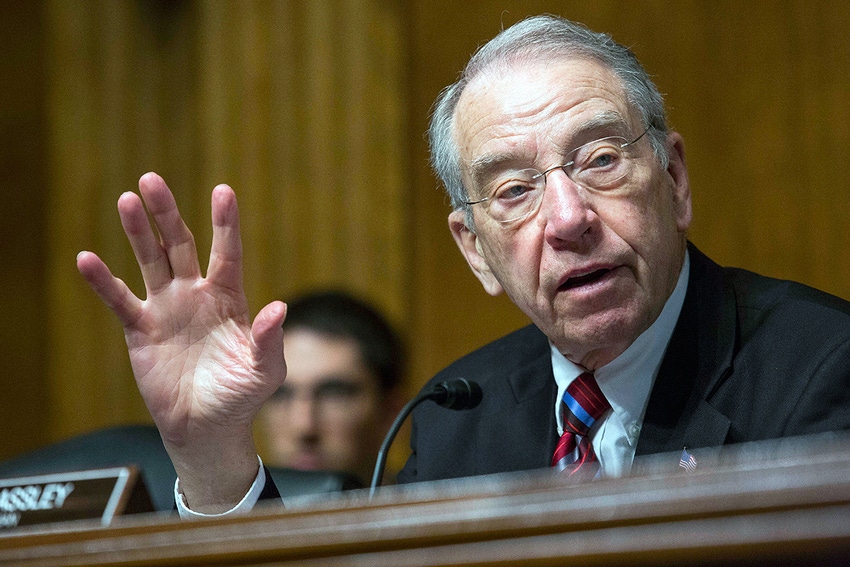June 7, 2017

Iowa Sen. Charles Grassley has asked the U.S. Government Accountability Office to review how USDA’s Farm Service Agency is implementing the “actively engaged” provisions of the Agriculture Act of 2014.
Grassley, who has authored numerous bills tightening the payment eligibility rules for farm programs, said he wants to know how many family and non-family members of farming operations are now receiving payments under the 2014 farm bill.
He is seeking a GAO review of how the Farm Service Agency has implemented the new payment regulations in the 2014 law, and their impact, if any, in reducing payments to persons who do not farm, the degree to which such problems exist and what changes are needed to strengthen the rules.
“I’m not giving up this fight,” he said in a press release distributed Wednesday (June 7). “I still have young farmers who write to me saying they cannot get started in farming because those who game the system get huge amounts of subsidies and bid the price of land up too high.”
Noting the budget situation for the next farm bill (scheduled in 2018) will be as challenging as it has ever been, Grassley said, “Removing non-farmers from farm programs isn’t a tough choice. It’s low-hanging fruit.”
2013 GAO report: ‘Shortcomings’
According to Grassley, a 2013 GAO report outlined shortcomings of the Farm Service Agency’s administration of the “actively engaged” rule and how difficult it was for the government to prove fraud related to program eligibility because of what he called unfixed loopholes.
In 2014, the senator led an effort to fix those loopholes that allowed farmers to exploit the system by using non-farming family members to receive additional subsidies from the government. Both chambers of Congress passed an amendment that included his reforms to farm program eligibility, but the amendment was significantly altered in conference.
The “actively engaged” rules eventually published by USDA under the 2014 law did limit the number of non-family members who could receive farm program payments to three, depending on the size and complexity of the farming operation aim to prevent abuses of farm subsidies. Non-family members must also meet a series of criteria to be deemed actively engaged in farming.
One way to meet the “actively engaged” requirement is to make a significant contribution of active personal management. For general partnerships and joint ventures, each additional member of the operation can receive up to $125,000 if the new member meets eligibility requirements, including being determined to be actively engaged in farming.
The 2014 farm bill required USDA, in new regulations, to add more specificity to the role that a non-family member must have to qualify for farm program payments. For example, general partnerships and joint ventures with non-family members must document the actions of members who claim significant contributions of active personal management to the farming operation.
500 hours of specific management
USDA defines significant contributions of active personal management as 500 hours of specific management activities per year, or 25 percent of the total management time necessary for the success of the farming operation. Also, USDA generally allows only one member of an operation to meet actively engaged in farming requirements this way.
“However, general partnerships and joint ventures comprised of family members are exempt from these new restrictions,” Grassley said. “As a result, the current set of rules governing farm program eligibility, particularly for family members of a farming operation, remain subject to criticism from rural and farm advocacy groups.
“These groups contend that current USDA eligibility requirements set a low threshold to qualify for payments, making it easy to add members for the sole purpose of increasing the farming operation’s payment limits and expanding its farm program payments.”
Grassley suggested the following questions for the GAO review:
What has been the composition of family and non-family members in large farming operations since 2014?
What is the maximum number of persons that a single operation qualified for farm program payments? Please break-down the eligibility of the eligibility of these people divided between management, spousal eligibility, labor, or land-owner rules and whether additional peanut-related payment limits were also claimed.
How many producers requested additional managers for farm program payments under the 2015 regulation related to Actively Engaged?
How many of the applications were approved or denied?
How many audits or spot checks were completed of these approved requests to verify compliance and what were the results?
How many operations would have needed to request additional management-related payment limits if the operation had not been comprised solely of family members?
Since enactment of the new rules, what is the maximum payment the USDA has paid to an individual farmer considering all possible payment limits?
What is the maximum amount collectively paid to a single operation organized as a joint venture or general partnership?
How do commodity certificates, which were reauthorized in the FY16 appropriations bill, impact payment limits?
What additional changes are needed, if any, to strengthen the actively engaged in farming rules and USDA’s implementation of these rules?
About the Author(s)
You May Also Like






